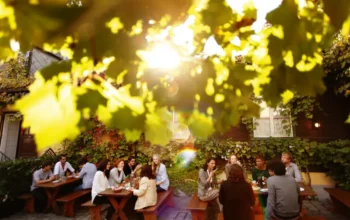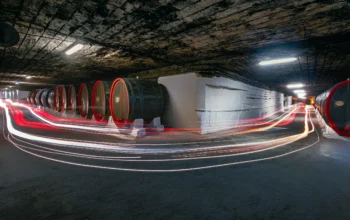The French village of Trépail is even quieter than I thought. The few houses there are deserted and the shutters are closed. Here and there a worn van drives by, with drivers looking curiously at us. Even though we are in Champagne; tourists are clearly not used to them here. Our car turns a corner and we arrive at Rue de La Mairie number 10. The time has come! Here is the home of David Léclapart: champagne maker, promoter of biodynamic viticulture and above all: living legend. I cannot believe my luck. After years of silent adoration, I am not just going to meet David; I am staying for a week to help with the harvest. - TEXT INGE DE JONG | IMAGE ALEJANDRO MUCHADA
2021 was a dramatic champagne year - but at David Léclapart's house, it's party time
A year to cry
For me, the champagne harvest may be a celebration; but for champagne farmers, there is little to celebrate this year. A severe winter frost was followed in April and May by 12 days of unexpected spring frosts to eight degrees below zero. As a result, as much as 20% to as much as 80% of the crop was lost. As if this was not enough, the Champagne region experienced heavy hail and rain in the summer. The humidity made the vines vulnerable to vintners' biggest fear: mildew. This fungus attacks the leaves of the vines, turning the juicy grapes into dry, shrivelled bundles of misery. Many champagne growers were able to limit the damage with chemical treatments. But the organic and biodynamic farmers could do nothing but watch helplessly. For some of them, more than 90% of the crop went up in smoke.
"This is the worst crop year of my life," David says as he pours a glass of water. He brings it as a fact and seems in fine spirits. I have just nervously shaken hands with him and we are sitting at a long dining table in a garage that serves as a hotel for his pickers this week. In the corner is a large, cardboard board with a drawn map of the world. Everyone who is coming to help this week is on it, in the country they are from. The name "Inge" points with a long bow to the tiny Netherlands. David's wife Carole comes in and sees me watching. "David loves people from other countries," she tells me. "We have people coming from Spain, France, Japan, the Netherlands, Sweden and Argentina."
Complex and rare
Indeed, in the late hours of Saturday afternoon, the nationalities trickle in one by one. Some pickers are old friends and fall around David and Carole's neck; others, like me, are there for the first time and shyly shake hands. David Léclapart is not just anyone then: his biodynamic champagnes are among the best in the world. Like other biodynamic farmers, David focuses on the soil health of the vineyard. He also takes into account the positions of the moon and planets, and the water and energy currents that run beneath the vineyard. After the grape juice is put into tanks and vats, David hands the process over to nature and stops any interference. Léclapart wines are made exclusively from one vintage (although they are not official vintage champagnes) and come from just four hectares of land where no chemicals and pesticides are used. The quality is high and the volume low, which makes Léclapart's champagnes not only fantastically complex but also quite rare. Bottles are only sporadically available online, even his "entry-level" champagne l'Amateur.
In the Léclapart home, this rarity is nonexistent. I notice this during dinner, when l'Amateur appears on the dining table in sixfold. David pours over twenty glasses full and scans all the names of the pickers, received by cheers and applause. Everyone gets a plate of crisp, warm pâté en croute and bread baskets of baguettes are passed around. The party has begun and immediately lasts until 3am.
Breakfast in the vineyard
At 7am the next morning, I am sitting at the same dining table. One picker after another comes in, welcomed by a hungover "bonjour" from those present. We drink a cup of coffee and eat a biscuit; we get the real breakfast later. The pickers are directed to some vans by David and his son Martin, and 15 minutes later we are at the first field. I am given a bucket and clippers, and David shows us how to pick grapes. My worries about my inexperience prove unfounded: you look for the stem of the bunch of grapes and cut it off there. That's really all there is to it. Grapes affected by mildew or Oïdium should also be cut off, but left on the ground. I get to work with Rui, a Japanese girl I met the day before. She loves organic champagne as much as I do, and busy talking, we start our working day.
When I told people back home that I was going to help with the champagne harvest, most frowned. "You rather than me," was the comment. After 15 minutes of picking grapes, I know why. Harvesting is not so much hard; it is killing your back. The vines are about a metre high, which means you have to move half stooping and half squatting through the vineyard. For ten minutes this is fine to do, then your muscles start to protest. So I am completely exhausted when, an hour and a half later, I hear shouts: "Tout le monde, le petit déjeuner est prêt!". Breakfast, thank God.
At the sight of breakfast, the pain pulls out of my back. At the edge of the vineyard, a long table is filled with cheese, sausages, baguettes, butter and chocolate. David's son Martin pulls open a bottle of red côteaux champenois: a light, cherry-flavoured wine from the Léclapart home itself. It is barely a quarter past nine in the morning, but the picture is right. The sun rises from behind the hills and warms our hands. I eat baguette with farmhouse pâté and sip my côteaux champenois.
Culinary friends
The combination of hard work, alcohol and food appears to be the theme of the week. Every day, we gather in the dining room around noon for lunch, which is spectacular without exception. David has culinary friends throughout the Champagne region and chefs from star restaurants L'Assiette Champenoise and Racine alternate in the kitchen. We get boeuf bourguignon, lemon chicken, tarte tatin and the crunchiest porcetta I have ever tasted. On the third day, chef Kazu of Racine restaurant puts kilos of homemade duck pâté with foie gras on the table, to great applause from the attendees. I discover that it was David who encouraged Kazu to start his own restaurant. He has this effect on more people. The pickers include Alejandro Muchada, a winemaker from Marco de Jerez, a historic wine region in Andalusia in Spain. Alejandro was so impressed by David's way of making champagne that he quit his job as an architect and joined David in producing Spanish wines under the Muchada-Léclapart name. Those bottles also appear regularly on the table. Never before have I added so many different wines to my Vivino account in one evening.
First dance
On the fourth day, harvest week comes to an abrupt end. So far we have only picked Chardonnay, and the fields of Pinot Noir that are left turn out to be almost completely destroyed by hail and mildew. In the morning, we pick a few more buckets per person from the fields, then it's done. As we hand in our buckets and clippers for the last time, I see David looking at the vineyard pensively for a moment. "Are you worried a lot?" I ask him. "Not at all," David replies. "It's unfortunate, but it's nature. Sometimes you get a lot, sometimes nothing. And now we are going for lunch!"
When we get back to Trépail, the party music is already approaching us. The table is set and, to my surprise, bottles of l'Apôtre appear on the table: my favourite champagne. David may have lost much of his harvest, but handing out champagne is still well in his system. I decide to convert this week's salary into a couple of Léclapart bottles. I am just about to ask him when I look out of the window and see him dancing, in the middle of the street. "Thanks Japan, thanks Sweden, thanks Spain!" he shouts to the slightly tipsy people around him. "We'll see this year's damage, but first let's dance."
Don't want to miss a single edition? Subscribe then subscribe to Winelife Magazine now!
Want to stay up to date with the best articles? Follow Winelife magazine on Instagram, Facebook and sign up for our fortnightly newsletter.




